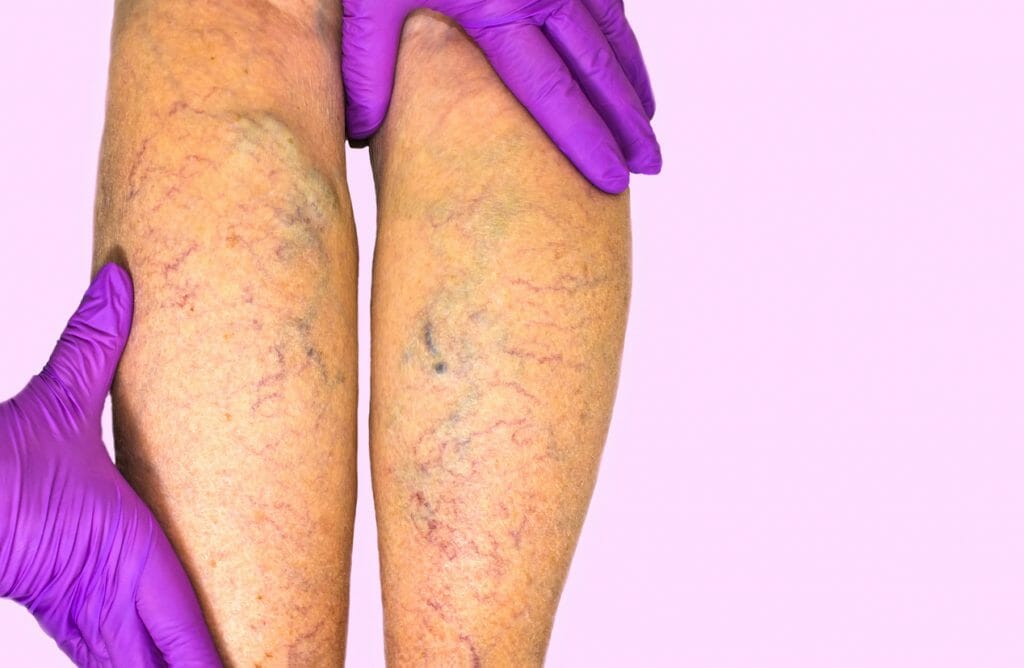What Causes Varicose Veins and Spider Veins?
 Varicose veins and spider veins share many of the same risk factors, causes, and treatment options.
About 20 percent of adults in the U.S. have varicose veins, those blue and purple veins surfacing along the calves and ankles. Spider veins, a thinner and less visible cousin of varicose veins, are more common, seen on more than 80 percent of men and women between 40 and 80 years old.
Both types of veins indicate a leakage of blood in the veins. Our body’s circulation system depends upon a network of arteries and veins to move blood and nutrients back and forth from the heart to the lower extremities. To return blood to the heart, valves in the leg veins open and close to ensure blood moves upwards and doesn’t slip back down and stretch the vein walls. Thusly, when these valves fail, varicose veins and spider veins appear.
Unlike varicose veins, spider veins aren’t confined only to the legs. Spider veins also crop up on the face, usually due to exposure to intense sunlight. Nevertheless, varicose veins and spider veins share many of the same risk factors and treatment options.
Varicose veins and spider veins share many of the same risk factors, causes, and treatment options.
About 20 percent of adults in the U.S. have varicose veins, those blue and purple veins surfacing along the calves and ankles. Spider veins, a thinner and less visible cousin of varicose veins, are more common, seen on more than 80 percent of men and women between 40 and 80 years old.
Both types of veins indicate a leakage of blood in the veins. Our body’s circulation system depends upon a network of arteries and veins to move blood and nutrients back and forth from the heart to the lower extremities. To return blood to the heart, valves in the leg veins open and close to ensure blood moves upwards and doesn’t slip back down and stretch the vein walls. Thusly, when these valves fail, varicose veins and spider veins appear.
Unlike varicose veins, spider veins aren’t confined only to the legs. Spider veins also crop up on the face, usually due to exposure to intense sunlight. Nevertheless, varicose veins and spider veins share many of the same risk factors and treatment options.
Varicose Veins & Spider Veins: Who’s at Risk
Although varicose veins and spider veins can happen to anyone, certain risk factors increase the chance you’ll get them at some point in your life. These risk factors include:- Age. The valves in our leg veins weaken as we get older, multiplying the likelihood of varicose veins and spider veins.
- Gender. Women are more prone to varicose veins and spider veins due to fluctuating hormone levels during pregnancy, pre-menstruation, and menopause. These changes affect the veins by relaxing the vein walls, which allows the blood to accumulate and extend vein walls.
- Pregnancy. Not only do hormone levels increase during pregnancy and dilate the veins, but the body produces more blood to nourish the mother and fetus, as well. This extra flow of blood puts pressure on the vein walls, leading to varicose veins. Fortunately, the enlarged veins usually disappear after delivery.
- Heredity. Your chances of getting varicose veins or spider veins heighten if a family member has had the same condition.
- Obesity. Carrying excess pounds stresses the veins, leading to weak valves and sluggish circulation.
- Sedentary Lifestyle. If your job requires that you sit or stand for prolonged periods, the veins in the legs have to work harder against the pull of gravity to pump blood to the heart.




